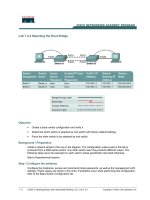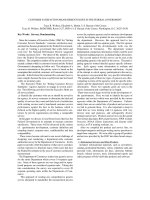Tài liệu KRONE - Guide - How Krone resolve the Bottleneck problem doc
Bạn đang xem bản rút gọn của tài liệu. Xem và tải ngay bản đầy đủ của tài liệu tại đây (568.11 KB, 8 trang )
KRONE
facts
How KRONE Can "Open the
Bottleneck"
KRONE BROADBAND
As the Internet market continues to explode, the
demand for high-speed bandwidth is growing at a
fast pace, driven mostly by growth in data volumes
as the Internet and related networks become more
central to business operations.
Drivers
The rapid growth of distributed business
applications, the proliferation of private networks,
e-commerce, and bandwidth intensive applications
(such as multimedia, videoconferencing and video
on demand-VOD); as well as the continuing
deregulation and privatisation of telecommunications
networks throughout the world, all help fuel the
demand for this bandwidth.
Broadband Access
Broadband access is one of the most crucial pieces
of next-generation networks and although carriers
are under tremendous pressure to keep costs down,
in order to meet future needs, strategic investments
are required to build and deploy next generation
backbones.
Service providers are utilising various technologies
and streaming techniques to move content closer
and closer to the edge of the network. These next-
generation networks ensure massive core capacity
but the challenge now is the delivery of broadband
over the last or first mile (local loop bottleneck) to
the customer.
" Connectivity choices made today can influence
tomorrow's broadband networks" .
The above statement is directly related to the
service providers profitability and as such is vitally
important to them. The utilisation of the new
KRONE Broadband modules will enable the
following:
1.Carriers with legacy networks to upgrade to
broadband delivery capability and more
importantly, for these incumbents to RETAIN
customers i.e. reduce churn
2.Service providers and CLECs to implement
the latest broadband technologies
Competing Technologies
There are currently a number of competing
technologies such as xDSL, cable modems,
broadband satellite, broadband fixed wireless etc
however the most promising technology capable of
delivering full service is Very-High-Data-Rate DSL
(VDSL). VDSL is both symmetric and asymmetric and
provides up to 52 Mbps of bandwidth over voice on
a single twisted pair copper loop. This copper cable
could be within an ILEC's legacy network or in a
CLEC's new FTTC rollout.
Broadband, the Potential
The potential for growth in broadband
infrastructure is massive. It is clear that carriers need
to upgrade their legacy networks to support
broadband. New players such as CLECs and service
providers are eagerly targeting this market utilising
KRONE (Australia) Holdings Pty Limited
2 Hereford Street Berkeley Vale NSW 2261
PO Box 335 Wyong NSW 2259
Phone: 02 4389 5000
Fax: 02 4388 4499
Tech Support: 1800 801 298
Email:
Web: krone.com.au
Copyright © 2004 KRONE (Australia) Holdings Pty. Limited
Job No.: 6221 V2 08/04
the latest technologies such as high speed DSL for
their broadband delivery.
By December 2003 there were 100 million
broadband lines. This was an increase of 63% from
the previous period in 2002 as reported by research
company Point Topic. Of this, copper based DSL
technologies account for 64% of the lines whilst
cable modem based broadband delivery was 36%.
DSL growth remained ahead of cable modem
and other broadband growth overall, growing at
32% in the second half of 2003 compared to a
modest 18% for cable modems in the same
period. The growing demand for broadband access
and its cost effective delivery to subscribers will
ensure this trend continues.
The Point Topic research indicates that DSL is the
connection of world choice. Total DSL subscriptions
surpassed 64 million lines, with the service's
popularity mostly attributed to the sharp rise
during the second half of 2003 in the number of
DSL subscribers in the Asia-Pacific and EMEA
regions, 31.5% and 38.7% respectively.
As reported by the Yankee Group, by 2008 more
than 8 million business DSL connections across the
region will generate $5.4 billion in revenue. It is
forecast that at this time the two dominant
markets, Japan and China, will hold more than
56% of the region's business DSL subscribers.
DSL more than doubled during 2002 and is
continuing to grow strongly throughout the world.
Global broadband access service revenue will rise by
more than US$136 billion over the next 6 years,
according to a new forecast from Pioneer Consulting.
The company predicts that total revenues will reach
US$229 billion by 2008, up from US$93 billion in
2002. Based on current development rates, there
" could" be up to 200 million DSL broadband
subscribers by 2005.
The KRONE Broadband Family
To enable KRONE globally to meet the challenge of
these new applications and to assist carriers in
" opening the last/first mile bottleneck" , KRONE
Australia has developed the " Broadband" range of
modules. Differentiated by purple printing on the
turrets, this new range complements the classic
HIGHBAND
®
which is utilised for in-building
delivery, thereby, seamlessly linking Access
NET
™
with Premis
NET
®
applications. This then provides
our customers with broadband " end-to-end"
connectivity.
The following is the range at present:
Modules
Ü Broadband 10
Ü Broadband 8 (standard)
Ü Broadband 8 (compact)
Ü Broadband 25
Outlet
Ü Broadband 8P4C pin in RJ45 format (purple
nose piece)
Ü Broadband 8P8C RJ45
Protection
Ü Broadband 10 pair protection magazine
Ü One pair protector (ComProtect
®
)
Ü 10 pair earth strip
Splitters
Ü LSA Direct for
Ü Central office applications
Ü NGDLC (Next Generation Digital Loop
Carrier)
Ü ONU (Optical Network Unit)
Ü Third party badged " dynamic" and
" standard" splitters as per in-country
customer premise equipment specifications
Ü Third party splitters for central office
applications
The Winning Edge
KRONE Australia commissioned an independent
test house, Power and Digital Instruments Pty
Region (Millions)
Americas 13165
Asia-Pacific 32179
EMEA 18770
“Top Ten” Broadband countries by number of lines.
Source: Point Topic - 23rd March 2004
Ltd, to evaluate the performance of the
Broadband range to the new VDSL standards
against other connectivity modules available in
the market.
A white paper on " The Critical Effects of Cable
Termination Equipment on VDSL Loop Performance"
is available from KRONE.
Quote from Consultant - Mr. George
Georgevits (B.E. Hons.)
" The graphs clearly demonstrate an advantage (dB)
with the KRONE Broadband module in channel
return loss and channel NEXT performance. Even a
few dB of additional channel headroom has
significant implications in terms of maximum
channel reach. It can have a big impact on overall
network rollout costs" .
Unique Properties of the KRONE Broadband
Series
The following are the unique features of KRONE
Broadband as identified by independent testing.
Ü The modules exhibited a higher
performance than the competitors in NEXT
and Return Loss.
Ü This translates to the capability to reach
longer distances than the competitors in
quality signal delivery and therefore open
greater potential revenue streams to the
service providers.
Ü The much smoother response of our
Broadband modules ensures a greater
quality of signal and therefore less
retransmissions which in turn leads to less
compensation needed to be provided by the
manufacturer.
Ü Broadband modules performed a degree of
NEXT compensation at the higher
frequencies, in other words, the modules
actually reduced NEXT.
Ü KRONE Broadband modules will provide
additional headroom when deployed onto
existing infrastructure.
As stated previously, the two main parameters
affecting broadband delivery over copper are
Return Loss (RL) and Crosstalk. The following
graphs, extracted from this testing clearly illustrates
the KRONE Broadband modules unique
performance.
KRONE
facts
The KRONE Broadband Family
Note Channel NEXT and RL graphs:
Competitor A 10 pair module
Competitor B 10 pair module
Competitor C 10 pair module
Competitor D 10 pair module
BB is KRONE’s Broadband module
The chart above shows the KRONE Broadband 10
module compared to other available, non-KRONE
modules for Return Loss at 0-12 MHz. From the
graph you can see that Broadband has a much
smoother response over the whole 12 MHz range
and performs better than the competitors. The
worst case mean return loss degradation for
Broadband is around 2 dB and for competitor
modules in the range of 5-6 dB.
C
rosstalk
is a disturbance caused by an electric or
magnetic field of one telecommunication signal
affecting a signal in an adjacent circuit and this can
cause a severe degradation in transmission.
There is more detail on this subject later in the
document. However, it is important to note that the
consultant's investigation found that the
Broadband modules performed a degree of NEXT
compensation at the higher frequencies. In the
following graph, below the 0 line indicates NEXT
compensation and the measurements above the
line indicate NEXT degradation.
From the graph above, it can be seen that the
KRONE Broadband module has the most stable
performance. The Broadband whole frequency
performance indicates a net positive influence that
no other module matches.
The Return Loss Performance of the KRONE
Broadband module at 30 MHz exhibits a far
superior performance to any competitor module.
Particularly at the higher end of the spectrum,
Broadband performs up to 6 dB better.
NEXT at 30 MHz shows that the Broadband
module induces no loss over the frequency
spectrum while all others contribute a net loss in
NEXT performance.
Application Areas for KRONE Broadband
There are numerous application areas that have
been identified such as:
Ü Direct central office delivery of VDSL i.e.
DSLAM in central office over copper to the
customer.
Channel Ret Loss Change Due to Modules at 0-30 MHz
Channel NEXT Change Due to Modules at 0-30 MHz
Channel Ret Loss Change Due to Modules at 0-12 MHz
Channel NEXT Change Due to Modules at 0-12 MHz
KRONE
facts
Ü Passive Optical Networks (PON's) with VDSL
for the " last mile" .
Ü Metro Ethernet, an emerging technology
which again utilises FTTC/FTTB and VDSL for
" first mile" delivery.
Ü Legacy network upgrades to a broadband
capability i.e. MDF, CCC and DP.
Ü xDSL applications in general.
Ü Futureproofing of networks.
Ü Migration of ADSL to VDSL: Drivers being:
Ü Increasing multimedia services (VOD)
Ü Bandwidth exceeds ADSL performance
Ü Migration to full service networks
Ü Replace multiple ADSL or E1/T1 Links
Ü VDSL link needed to satisfy thirsty
business applications such as
CAD/CAM
About the ITU-T FS-VDSL Focus Group
The drivers of the new VDSL standards were sixteen
network operators and fifty two equipment
vendors, who envisage a new multi-service video-
centric network platform based on VDSL delivery,
which will enable operators and service providers to
provide end-users with a rich mix of video, data and
voice services. By utilising global ITU-T standards,
greater economies of deployment are expected.
The use of VDSL rather than today's typical ADSL
provides significant increase in bandwidth enabling
provision of multiple digital TV channels including
HDTV and on-demand services, along with high-
speed data and multiple voice channels.
Emerging Technology
A new application for the Broadband modules,
" Metro Ethernet" , is now emerging. Based on the
traditional local area network Ethernet technology,
so called Metro-Ethernet services are emerging as a
new form of high speed Internet access offering
wide-range scalability.
Ethernet in the First Mile (EFM)
In November 2000, the IEEE 802.3 Ethernet
working group formed an Ethernet in the first mile
study group. It was christened as " first mile" to
emphasise the need to put end customers first. It is
expected that the task force will adopt Ethernet
over VDSL, which means using an Ethernet Media
Access Control layer (MAC) on top of the VDSL
physical layer. Ethernet over VDSL (EoVSL)
technology is the ideal solution for delivering 14
Mbit at 12 Mhz and up to 52 Mbit at 30 Mhz
utilising KRONE Broadband modules.
Metro Ethernet
Metro Ethernet services take the well proven and
accepted benefits and advantages of Ethernet LANs
such as low cost equipment, efficient and proven
technology to the public space with carriers and
service providers.
At this time, EFM for residential access is currently
mostly an Asia-Pac phenomenon, and will largely
remain so through to 2006. Reasons for this include
heavy reliance on Multi-Dwelling Units (MDUs),
short local loop lengths, low labour costs,
government support, and, particularly in the case of
China, the need to deploy new infrastructure.
EoVDSL (Ethernet over VDSL)
EoVDSL technology enables network designers to
build high performance access networks for multi-
unit buildings (MxU) and enterprise campus
environments. MxU buildings include hotels,
residential multi dwelling units (MDUs) and
commercial multi tenant units (MTUs). Enterprise
campuses include manufacturing sites, educational
campuses and hospitals.
As data rates in these environments are suitable
for multiple channels of video service, in addition to
voice and data applications, the potential need for
KRONE's Broadband connectivity is clear. EoVDSL is
also ideal for network access to residential
customers from curbside distribution boxes and
nodes and again, our new KRONE Broadband
products are particularly applicable here.
VDSL, What Is It?
VDSL (very high-speed digital subscriber line) has
sufficient bandwidth to deliver two or more streams
of uncompressed MPEG-2 video, with plenty of
overhead for broadband Internet access and other
digital services. Specialised implementations of
VDSL that are also promoted for video applications
include long-reach Ethernet and Rate Adaptive DSL
Ü Targets both Fibre to the Curb (FTTC) and
in-building applications
Ü High downstream bandwidth for distances
up to 1 mile or 1.5 Km
Ü 50/30 Mbps up to 300 metres
Ü 36/12 Mbps up to 1000 metres
Ü 15/3 Mbps up to 1500 metres
VDSL is Designed to Allow
Ü Three video streams to run concurrently to
three TVs. This is to suit typical usage
demographics.
Ü Life line POTS telephone (splitter required)
Ü Highspeed Internet 2-3Mbit (downstream)
Ü VoIP additional telephone lines, fax, alarm
Ü Video on Demand
It is very interesting to note that Korea who are
the world leaders in the utilisation of ADSL are
rapidly upgrading their networks to VDSL. This
migration will allow services such as Video On
Demand (VOD) to be adopted.
What the Physical Network Entails
Ü
D
igital HHead EEnd
- the storage medium for
content, this can be inclusive of a satellite
downfeed or fed by fibre from a shadow
Head End. This can serve a group of
exchanges on a fibre ring or star (FTTEx).
Ü
F
ibre DDistribution ffrom EExchange
- this is a
PON (Passive Optical Network) system to
active CCCs adjacent to passive copper
cabinets (FTTCab or FTTN) or directly to
multi tenant buildings (FTTB). The PON will
probably be APON (ATM PON) although
standards include the use of EPON (Ethernet
PON).
Ü
F
ibre tto CCopper
- the PON will terminate in
an ONU with a VDSL DSLAM and be linked
KRONE
facts
into the existing copper distribution
network with a splitter.
Ü
C
ustomer TTermination
- the line will
terminate on a splitter and CPE VDSL
modem.
Connectivity/Delivery Issues
Any successful deployment of a broadband service
in reality begins with the establishment of a reliable,
high quality, well-engineered local loop.
Field and laboratory tests have shown that legacy
infrastructure in the access network and in
customers premises can be an impediment to
higher bandwidth and higher speed services. The
transmission characteristics of old copper
infrastructures can lead to increased bit errors,
slowing down of transmissions and increasing
traffic due to signal reflections, in particular at
junction or interconnect points (also known as
impedance mismatches). The new Broadband
modules are designed for this segment of the
network to maximise delivery capability.
With legacy network upgrades, carriers will be
faced with a variety of lines and differing quality in
the OSP. The ability of a specific copper pair to
support a broadband service depends on a number
of factors:
Ü Basic line impairments: The presence of
loading coils, line taps, leakage, or physical
faults on a line means that it cannot
support transmission of high bandwidth
signals.
Ü Attenuation: To successfully carry a
broadband service, a line must be capable
of transmitting a minimum signal level from
one end to the other (that is, it must exhibit
a minimum level of attenuation).
Ü Noise: When noise, generated by crosstalk
or external sources is superimposed on the
line, the overall signal-to-noise ratio (SNR) is
impaired. This factor can reduce effective bit
rate or loop reach of the service.
Crosstalk, What Is It?
The independent testing conducted for KRONE
Australia showed a unique USP of the Broadband
family minimising crosstalk, one of the most critical
factors in effective broadband delivery.
Crosstalk can be categorised in one of two forms:
Ü Near end crosstalk, commonly referred to as
NEXT, is the most significant because the
high-energy signal from an adjacent system
can induce relatively significant crosstalk
into the primary signal.
Ü The other form is far end crosstalk, or FEXT,
which is typically less of an issue because
the far end interfering signal is attenuated
as it traverses the loop.
Broadband Modules NEXT Compensation
As mentioned earlier in the document, the
Broadband modules performed a degree of NEXT
compensation at the higher frequencies, thereby
improving signal quality.
What Causes Return Loss (RL)?
Variations in the impedance of a cable produce RL;
therefore, anything that affects impedance
tolerance affects RL. This includes the basic
construction of the cable, from the size, shape, and
make-up of the conductors; choice and
manufacturing of the insulation or dielectric; and
choice of shield elements and materials. Return loss
can also be dramatically affected by the choice of
connectors and other passive components.
Legacy Network Upgrades
With the above in mind, when service providers
need to upgrade their networks to a broadband
capability on legacy cable infrastructure, the choice
of connectors utilised to introduce the service can
have a crucial impact on the whole circuit
performance. Often the upgrading can be as
simple as replacing the physical cross connect in
the BD, DLC or DP with Broadband modules
improving return loss and thereby improving the
transmission characteristics of the line. KRONE
Broadband modules will provide additional
headroom when deployed onto existing
infrastructure.
So What Does This Mean to a Service Provider?
Ü Due to this unique KRONE Broadband
module performance, the service providers
can expect greater quality of signal delivery
KRONE
facts
therefore reducing resends and the required
compensation requirements.
Ü One of the greatest challenges today for the
incumbents is customer retention. By
utilising the KRONE Broadband module
family, they will be able to quickly offer
access to the latest technologies
Ü Perhaps the greatest benefit of all is the
extension of reach the KRONE Broadband
family offers and therefore the increase in
the amount of customers service providers
can supply. This translates to higher
revenues to the provider.
Conclusion
KRONE Broadband modules are the highest
performing available today. They will enable carriers
and service providers to develop and deploy
network architecture that will:
Ü Allow legacy networks to be upgraded to a
broadband delivery capability
Ü Enable service providers to migrate to the
latest technology with minimum
expenditure
Ü Will provide a futureproof foundation for
growth
Ü Will provide the path to NEW revenue
streams for the service provider
What KRONE Can Offer
Ü " Broadband" copper connectivity in the
central office and active or passive cabinets.
Ü Complimented by HIGHBAND
®
for the
building cabling thereby providing seamless
broadband delivery.
Ü " Broadband" copper connectivity for legacy
network upgrades. BD/CCC/DP
Ü LSA Direct with built in VDSL splitter
with/without protection (overvoltage or
maintenance free).
Ü Third party badged " dynamic" and
" standard" splitters as per in-country
customer premise equipment specifications
Ü Digital Head End - fibre frames, connectivity,
patching, pigtails and monitoring at both
ends.
Ü Fibre Distribution from Exchange - fibre
frames, connectivity, patching and pigtails.
Ü Fibre closures with management and PON
splitters.
Ü Upgrade or new build with Broadband
modules to offer enhanced throughput in
the ranges up to 12 MHz and 30 MHz.
Ü Comprotect for both ADSL and VDSL
applications.
KRONE (Australia) Holdings Pty Limited
2 Hereford Street Berkeley Vale NSW 2261
PO Box 335 Wyong NSW 2259
Phone: 02 4389 5000
Fax: 02 4388 4499
Tech Support: 1800 801 298
Email:
Web: krone.com.au
Copyright © 2004 KRONE (Australia) Holdings Pty. Limited
Job No.: 6221 V2 08/04









